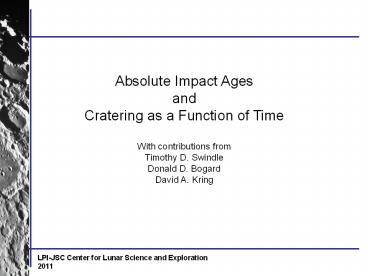LPI-JSC Center for Lunar Science and Exploration - PowerPoint PPT Presentation
Title:
LPI-JSC Center for Lunar Science and Exploration
Description:
Absolute Impact Ages and Cratering as a Function of Time With contributions from Timothy D. Swindle Donald D. Bogard David A. Kring 40K (half-life 1.3 Ga) decays to ... – PowerPoint PPT presentation
Number of Views:64
Avg rating:3.0/5.0
Title: LPI-JSC Center for Lunar Science and Exploration
1
Absolute Impact Ages and Cratering as a Function
of Time With contributions from Timothy D.
Swindle Donald D. Bogard David A. Kring
2
K-Ar Geochronology Method
- 40K (half-life 1.3 Ga) decays to 40Ca (89) and
- 40Ar (11) like sand through an
hourglass. - Rate proportional only to amount of 40K T1/2
- Measure amount 40K remaining 40Ar formed.
- Decay Eq ln (N / No) e -?t
- Age is t (1/?) ln ((40Ar/40K) (?/?e)
1) - where ? ln 2 / T1/2 is the total decay constant
and the sum of ?e (decay of 40K to 40Ar) and ?ß
(decay of - 40K to 40Ca).
40K
40Ar, 40Ca
3
Ar-Ar Geochronology Method
- Irradiate a K-bearing sample with neutrons to
produce 39Ar from 39K - (The nuclear reaction is 39K (n, p) 39Ar )
- 39Ar becomes a proxy for K is located in same
lattice site as 40Ar from 40K - Precisely measure with a mass spectrometer the
Ar isotopic ratio, 40Ar/39Ar, eliminating the
need to measure absolute concentrations of both K
and Ar. - Age given by t (1/?) ln
((40Ar/39Ar) J 1) - J is a factor calculated from standards of known
age irradiated with unknown samples. Age, t, is
thus calculated relative to a standard age. - The Ar-Ar method is more reliable than the K-Ar
technique for most samples is now almost
exclusively used. It is also ideal for small
samples (e.g., impact melts from the Moon and in
meteorites). - Commonly degas measure Ar from sample in
increasing temperature steps to examine age in
different lattice sites.
4
Ar-Ar Geochronology Method
- Some Issues
- Age of unknown sample only as accurate as age of
standard sample. - Sample may have contained 40Ar at the timeof
formation. Resolve with isochron plot of
40Ar/36Ar vs. 39Ar/36Ar (shown here) or - 36Ar/40Ar vs. 39Ar/40Ar.
- Age is calculated from the slope
- Inherited 40Ar is given by the intercept
- Sample may have lost some 40Ar by diffusion out
of grain surfaces. - Prior loss typically revealed in Ar released at
lower extraction temperatures.
5
Simple Example of an Ar-Ar Age Spectrum
- Age boxes in red, K/Ca ratio in blue, for each
temperature step.
- Slight prior diffusion loss of 40Ar at
low-temperature. - Varying K/Ca ratios indicate different K-bearing
phases with same K-Ar age.
Low temperatures
High temperatures
Yamaguchi et al. (2001)
6
Ar-Ar Geochronology Method
(magmatic example)
Step Heating
Plateau ages of 1375 Ma
Low temperatures
High temperatures
Swindle Olson (2004)
7
Ar-Ar Geochronology Method
(magmatic example)
Step Heating
Low-T phases lost Ar or were degassed and,
thus, do not reflect age of crystallization.
Low temperatures
High temperatures
Swindle Olson (2004)
8
Ar-Ar Geochronology Method
(magmatic example)
Step Heating
The nuclear reaction may create a recoil
effect that moves 39Ar from a K-rich phase into
a high-Ca, low-K phase, in this case pyroxene,
producing a fictitiously low age in the highest
T steps.
Low temperatures
High temperatures
Swindle Olson (2004)
9
Ar-Ar Geochronology Method
(impact melt example)
Plateau age of 3800-3900 Ma
Degassing event lt2000 Ma
Swindle et al. (2009)
10
An Example of the Methods Application
Apollo The radiometric ages of rocks from
the lunar highlands indicated the lunar
crust had been thermally metamorphosed 3.9
4.0 Ga. A large number of impact
melts were also generated at the same
time. This effect was seen in the Ar-Ar
system (Turner et al., 1973) and the U-Pb
system (Tera et al., 1974). It was also
preserved in the more easily reset Rb-Sr
system. (Data summary, left, from Bogard,
1995.) A severe period of bombardment was
inferred.
Bogard (1995)
11
References
D.D. Bogard (1995) Impact ages of meteorites A
synthesis. Meteoritics 30, 244-268. T.D.
Swindle, C.E. Isachsen, J.R. Weirich, and D.A.
Kring (2009) 40Ar-39Ar ages of H-chondrite impact
melt breccias. Meteoritics Planet. Sci. 44,
747-762. T.D. Swindle and E.K. Olson (2004)
40Ar-39Ar studies of whole-rock nakhlites
Evidence for the timing of aqueous alteration on
Mars. Meteoritics Planet. Sci. 39, 755-766. F.
Tera, D.A. Papanastassiou, and G.J. Wasserburg
(1974) Isotopic evidence for a terminal lunar
cataclysm. Earth Planet. Sci. Lett. 22,
1-21. G. Turner, P.H. Cadogan, and C.J. Yonge
(1973) Argon selenochronology. Proc. Lunar
Planet. Sci. Conf. 4th, 1889-1914. A. Yamaguchi,
G.J. Taylor, K. Keil, C. Floss, G. Crozaz, L.E.
Nyquist, D.D. Bogard, D.H. Garrison, Y.D. Reese,
H. Wiesmann, and C.Y. Shih (2001)
Post-crystallization reheating and partial
melting of eucrite EET90020 by impact into the
hot crust of asteroid 4Vesta 4.50 Ga ago.
Geochim. Cosmochim. Acta 65, 3577-3599.








![[May 2018 201-450] New LPI 201-450 Practice Exam Questions| Killtest PowerPoint PPT Presentation](https://s3.amazonaws.com/images.powershow.com/9058587.th0.jpg?_=20180519021)




















